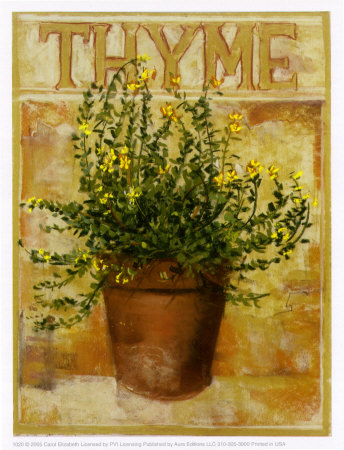
Image: Chalk Board Herb Garden Gift Set - Gift from Thompson & Morgan

It's easy to grow herbs indoors if you haven't got an outside growing space When growing mint in a container, lift and divide the plant yearly to maintain health and vigour. Make sure the container has drainage holes or water logging will kill the plant, and bury it so the top is hidden under a thin layer of soil. Some herbs like mint and Sweet Woodruff can be invasive making it a good idea to grow them in sunken containers like old buckets or plastic pots, to restrict root growth. It’s also worth protecting pots in severe icy weather by placing them against a house wall and/or wrapping the pot in bubble wrap. Make sure your containers have adequate drainage holes and are raised on bricks or 'pot feet' to prevent water logging in the winter. Over-feeding can cause the leaves to lose their pungent flavour so don't be too generous. Feed your pot-grown herbs regularly with balanced fertiliser throughout the growing season, following the manufacturer's instructions. The best compost to grow herbs in is loam-based, like John Innes. Alternatively, choose relatively deep pots, especially for large shrubby herbs like bay trees and rosemary. Go for a purpose-made vegetable raised planter which you can position right outside your back door, on your patio, or even on your balcony. Growing herbs in pots and containers is a great way to grow fresh produce in smaller spaces. Image: Herb Garden Planter from Thompson & Morgan Growing herbs in pots and containers can be just as productive as planting them in beds Sown in late summer, herbs like coriander, parsley and chervil will continue to grow throughout the winter as long as you protect them with a cloche. Sow the herbs you use most directly into the soil between rows of veggies, or as edging to beds. The tall, feathery foliage of fennel looks great in a herbaceous border, and its yellow flowers are sure to attract to bees and butterflies to your garden. You can also plant thyme and creeping savory in the gaps between paving stones – these tough plants will withstand light foot traffic, releasing their delicious scent whenever someone steps on them. Go for herbs that contrast with your flowers, and those, like thyme and basil, whose leaves add extra depth and texture to your planting.įor an informal edge to your garden path, try low-growing herbs like chives and thyme. If you don't have the space for a dedicated herb garden, they also make a great addition to flower beds and borders. And combining the silver-grey foliage of sage with the blue flowers of borage or the orange flowers of calendula (pot marigold) creates a fragrant ornamental feature made entirely from edible flowers. Growing herbs outdoors in a dedicated herb garden makes harvesting easier and creates a heady scent on hot sunny days.

If you have the space, a dedicated herb garden looks and smells great Harden off plants in a cold frame before planting into their final positions. Sow perennial herbs like sage, rosemary, chives and fennel in the spring, under cover in the warmth, and then pot them on when they’re big enough to handle. You may find half-hardy basil performs well indoors on a sunny windowsill if the summer is particularly wet or cold. Plant them out only when all risk of frost has passed. You can prick out seedlings and grow them on before hardening them off.

Sow at intervals of three to four weeks to ensure a continuous supply of fresh leaves.Īlternatively, sow most of your herbs under cover in seed trays or modules and plant them out at a later date, according to the instructions on individual seed packets. This is especially important for chervil and dill because they’re difficult to transplant. Sow hardy annual or biennial herbs like parsley, coriander, dill, and chamomile from March until August, directly into their final positions. Start herbs off under cover to protect them until the weather is warmer Shady garden? Herbs that grow in moist, shady conditions include chervil, parsley, meadowsweet, mint, lemon balm, and chives. Many herbs like rosemary, sage, thyme and lavender grow particularly well in coastal gardens. If you have very acid soil, add some lime when preparing the planting area.

Many herbs will tolerate a slightly acid soil, but the best pH-level for growing herbs is neutral to alkaline. You may also benefit from growing your herbs in a raised bed to ensure sharp drainage. If you have heavy clay soil then incorporate some coarse grit and organic matter like well-rotted manure or compost to improve drainage. Ideally herbs like a sunny, sheltered location with well-drained soil. Try growing herbs outside in a dedicated herb garden, a raised bed, a vegetable plot or even among the flowers in your borders – the array of different foliage and flower colours available means many herbs are as decorative as they are delicious and medicinal. Many herbs, like chives, look as good as they taste


 0 kommentar(er)
0 kommentar(er)
